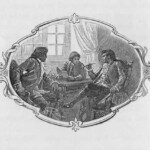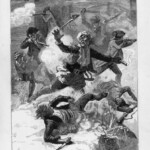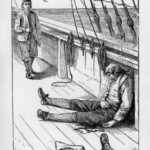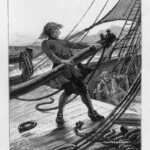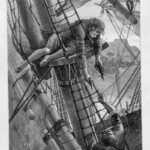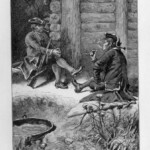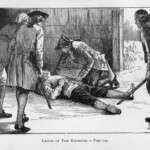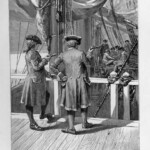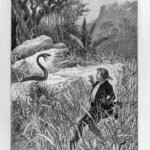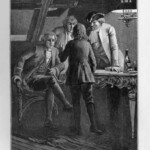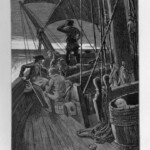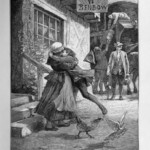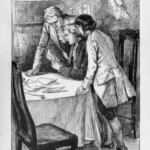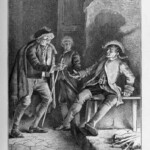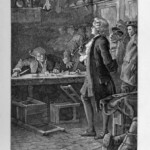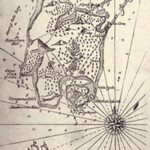There have been many posthumous illustrative treatments and cinematic adaptations of Stevenson’s most famous work, Treasure Island, from N.C. Wyeth’s famous illustrations in the 1930s, through to Walt Disney’s various adaptations, from the definitively influential 1950 version starring Robert Newton version to 2002’s Treasure Planet. Stevenson was consciously writing popular fiction for a popular audience, which has been well documented by recent literary criticism. However, a major part of popular literature is how it intersects with popular visual culture. This was as true at the end of the nineteenth century as it is today. Consequently, Stevenson was always interested in the illustration of his work, not only for the commercial benefits of increased circulation, but also for their artistic merit in entertaining his readers. In fact, despite its current fame and enduring popularity, Treasure Island did not make Stevenson a household name. As Roger Swearingen records,Young Folks actually received complaints about the story in its original form and unlike The Black Arrow (1883), it did nothing to raise the paper’s circulation.[1]
Unusually for a Young Folks story, Treasure Island only received one illustration, most likely because of Stevenson’s relative lack of fame. Stevenson does not seem to have been concerned about this; he writes to Henley in September 1881, “The terms are £2, 10s. a page of 450 words; that’s not noble, is it? But I have my copyright safe. I don’t get illustrated—a blessing; that’s the price I have to pay for my copyright”.[2] Young Folks published Treasure Island in 17 weekly instalments from 1 October 1881 to 28 January 1882. However, even before this publication, he was thinking about book publication. He writes in the same letter: “I’ll make this boys’ book business pay; but I have to make a beginning. When I’m done with Young Folks, I’ll try Routledge or some one. I feel pretty sure the Sea Cook will do to reprint, and bring something decent at that”.[3] Two months later, in November 1881, he again writes to Henley, and expresses a desire for illustration for a book version of the story: “In five weeks, six at the latest, I should have a complete proof of Treasure Island. It will be from 75 to 80,000 words; and with anything like half good pictures, it should sell. I suppose I may at least hope for eight pic’s? I aspire after ten or twelve. You had better”.[4] The eventual publisher was Cassell and Company of London, who published the first book version of Treasure Island in 1883, but without illustration.
The first illustrated edition of Treasure Island, according to Swearingen, was actually published in America in mid-February, 1884 (Boston: Roberts Brothers), with four illustrations by the artist F. T. Merrill. The first English illustrated edition was published in 1885, with a suite of illustrations by a French illustrator, Georges Roux (1850-1929). At this point, the history of the illustrations becomes a little murky. Swearingen records that this 1885 edition contained “twenty-one illustrations and an illustrated title page. Two of these illustrations are from the American edition, the rest by various other illustrators”.[5] The confusion comes from an analysis of two early illustrated samples. An 1885 first edition in the National Library of Scotland contains 25 plate illustrations, a title-page vignette, and an illustrated frontispiece; including the map, this makes 28 illustrations in total. Here, three of Merrill’s pictures are reproduced, plus one unidentified picture opposite page 260. The map must be attributed to Stevenson (although this is famously a later reproduction of the original map that was lost on its way to Cassell and Company). The remaining 24 illustrations are all, as far as is discernable, designed by Roux. Roux’s pictures all appear in a later imprint of this edition from 1889, with three of Merrill’s illustrations (figs. 9, 18 and 21), plus a closing vignette on p. 292 (fig. 28). All the images in this catalogue are reproduced from this 1889 imprint, and the titles are taken from the “List of Illustrations” given at the beginning of the book.
Stevenson seems to have had mixed feelings about Roux’s illustrations. In a letter of 28 October 1885, just before the release of the first illustrated edition, Stevenson writes to his father:
An illustrated Treasure Island will be out next month. I have had an early copy, and the French pictures are admirable. The artist has got his types up in Hogarth; he is full of fire and spirit, can draw and can compose, and has understood the book as I meant it, all but one or two little accidents, such as making the Hispaniola a brig. I would send you my copy, but I cannot; it is my new toy, and I cannot divorce myself from this enjoyment.[6]
The “French pictures” referred to here are Roux’s. He was clearly content with this illustrative treatment, on which he placed great importance; in 1887, Roberts Brothers threatened to publish another illustrated version with “disgusting” illustrations, and Stevenson wrote in desperation to Charles Scribner to obtain Roux’s illustrations from Cassell and Company. However, he qualifies his praise of Roux by adding that “the French faces jar”. In the end, the next American illustrated edition was published in 1902 by Scribners with illustrations by Walter Paget.[7] Appropriate illustrative interpretation was important to Stevenson. This catalogue therefore represents a set of illustrations that the author himself found to be appropriate, albeit with misgivings, and should be viewed in this light.
[1] Roger Swearingen, The Prose Writings of Robert Louis Stevenson: A Guide, (Connecticut: Archon Books, 1980), p. 63.
[2] Robert Louis Stevenson, The Letters of Robert Louis Stevenson, ed. Bradford A. Booth and Ernest Mehew (New Haven and London: Yale University Press, 1994), 8 vols. 3:229.
[3] Ibid.
[4] Robert Louis Stevenson, The Letters of Robert Louis Stevenson 3: 253.
[5] Roger Swearingen, The Prose Writing, p. 63.
[6] Robert Louis Stevenson, The Letters of Robert Louis Stevenson, 5: 145.
[7] Roger Swearingen, The Prose Writings, p. 63.
All images Courtesy of the The Writers Museum


